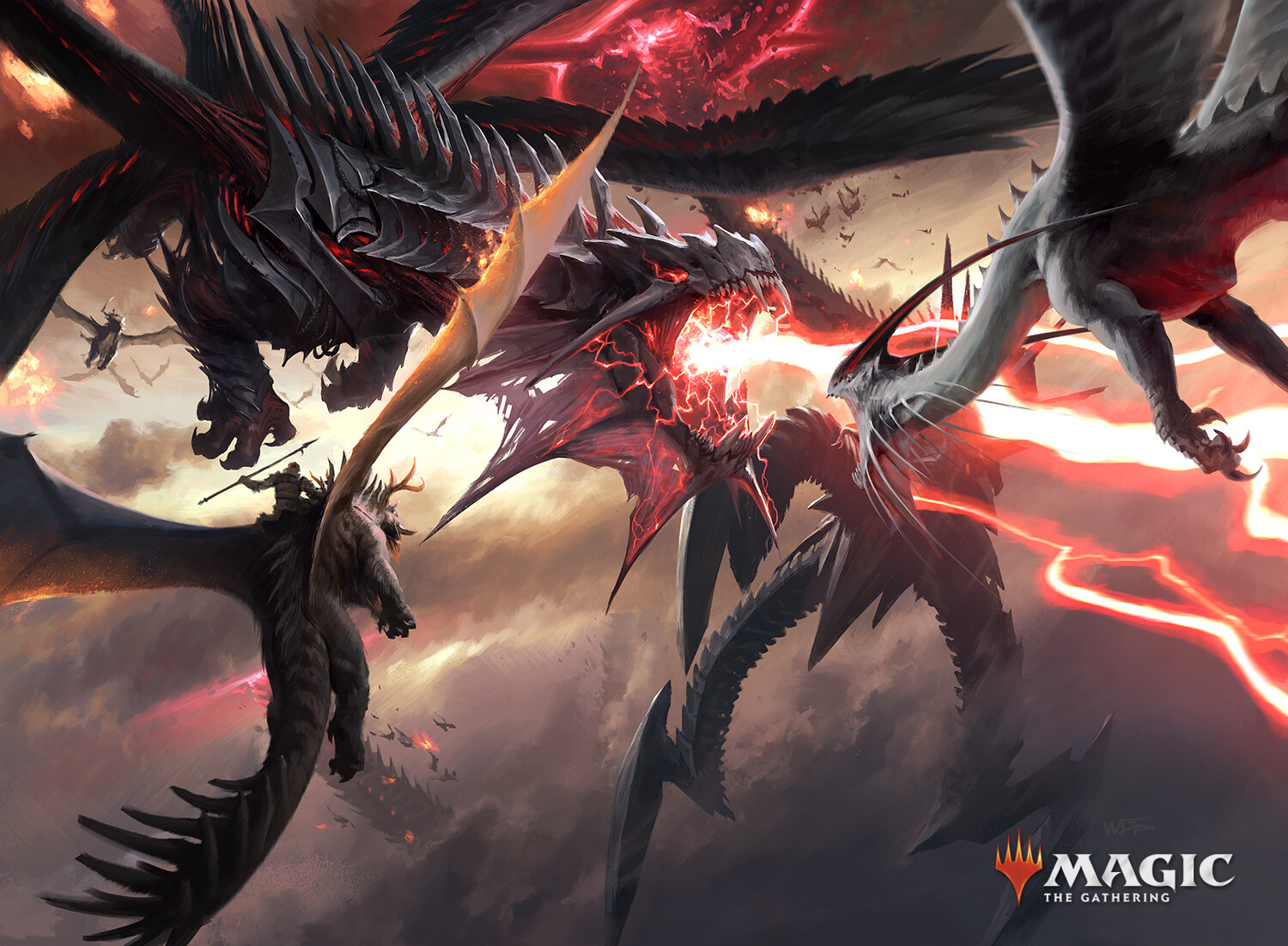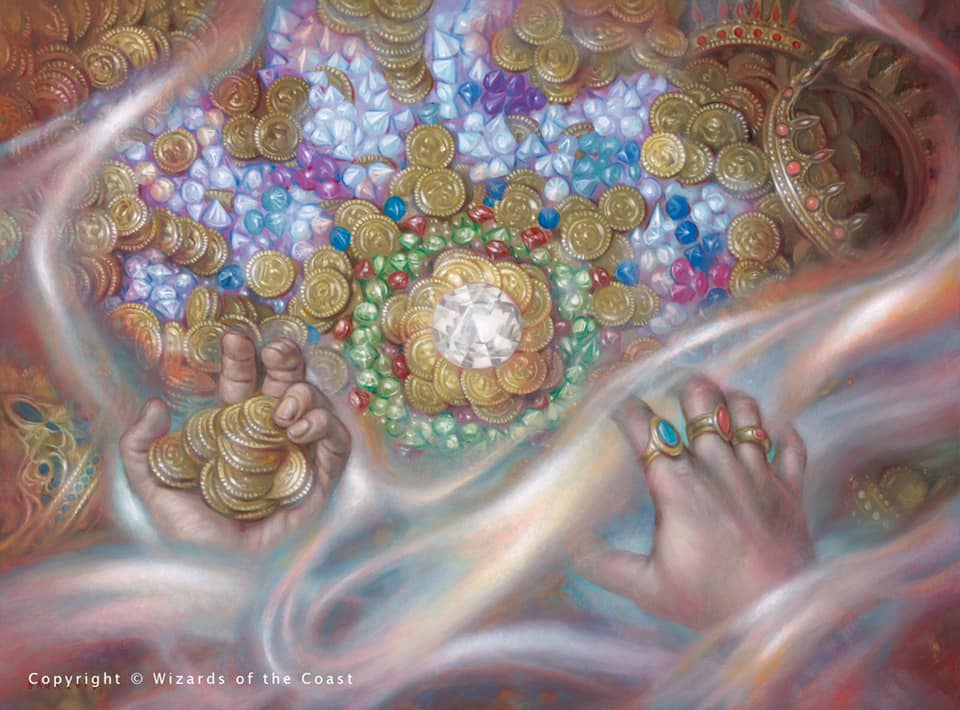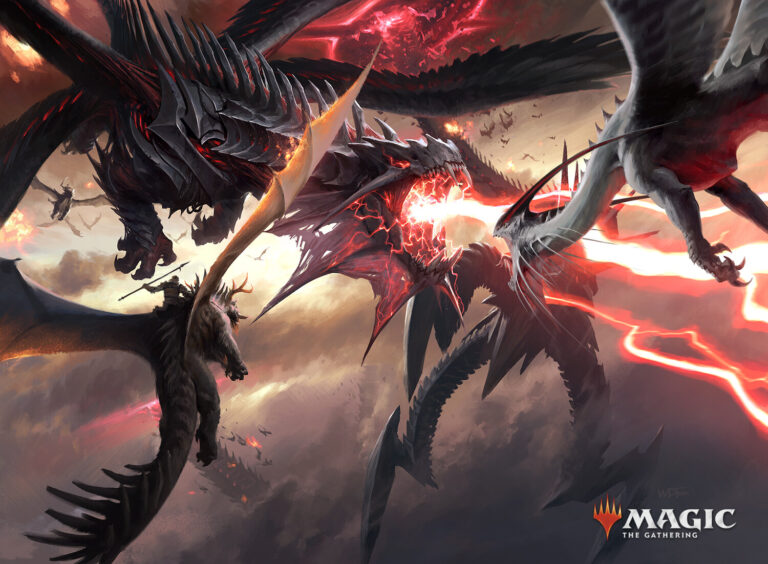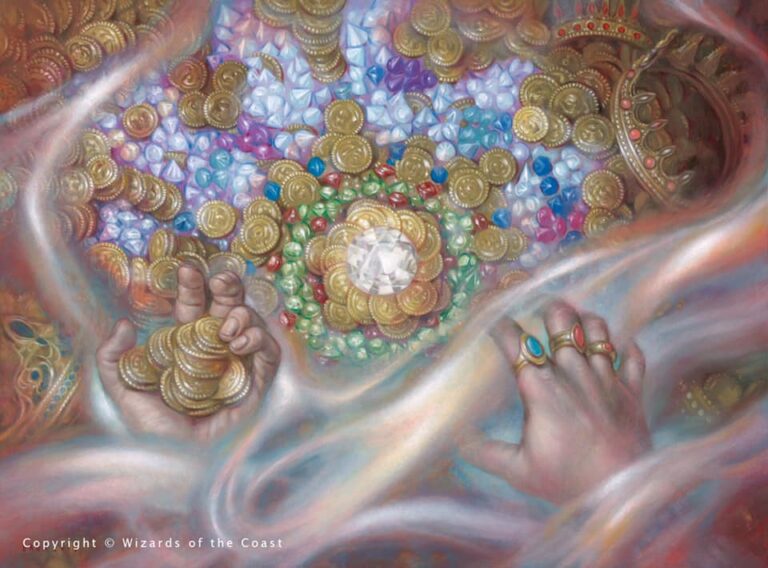Initially, before the new rule about sharing the commander tax was introduced, Yoshimaru, Ever Faithful was paired with another partner, a wild horse named Keleth, Sunmane Familiar. Together, they created a top-tier mono-white aggro archetype that could crush any opponent’s hopes.
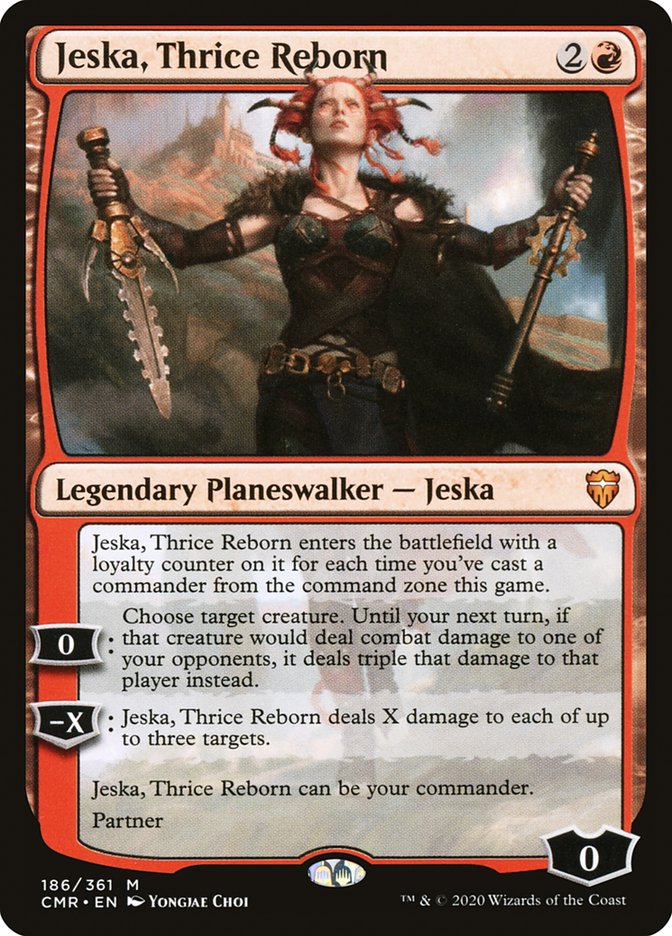
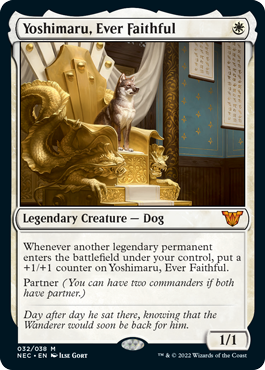
After the shared tax rule was implemented, the community questioned the future of the partner mechanic, thinking this handicap would be too severe. However, some people wasted no time and came up with the idea of pairing the little Chihuahua, Yoshimaru, Ever Faithful, with an additional color, without the need to cast the second Commander. Various strategies were explored, but the most effective one turned out to be red, which could provide both pressure on the board and the opponent’s life total. The focus shifted to a warlike Planeswalker, useful in the late game… Jeska, Thrice Reborn!
I’m Andrea Bosco (Re del Commander on Moxfield), and this is my decklist that we’ll be analyzing today!
This pairing is truly explosive and notably consistent, as it manages to be aggressive in the early turns and can suddenly shift into a sort of midrange strategy if things become more complicated than expected.
Let’s break it down and analyze the two Partners:
- Yoshimaru, Ever Faithful is clearly the deck’s primary focus. This 1-cost “Dog” creature gets a +1/+1 counter whenever a legendary permanent (including lands) enters the battlefield under its controller’s control. In just a few turns, this little Chihuahua can easily grow into a Neapolitan Mastiff.
- Jeska, Thrice Reborn is a supporting element, though not to be underestimated, that can help clear an annoying board or make one of our creatures lethal. This 3-cost Planeswalker enters the battlefield with X loyalty counters, where X is the number of times a Commander has been cast from the command zone. With its +0 ability, a target creature will deal triple damage to an opponent until end of turn. Its -X ability deals X damage to up to three targets.
Gameplan
The game plan is straightforward and effective: Yoshimaru, Ever Faithful will always be cast on turn 1, unless you have creatures with abilities similar to Mother of Runes in hand (to protect Yoshimaru and avoid wasting its potential, as the commander tax increases, making the Chihuahua less effective). In the following turns, you’ll play creatures that can annoy and pressure the opponent while also boosting Yoshimaru, making it bigger and harder to deal with. The deck doesn’t rely on combos; instead, it uses rigorous combat phases to determine the true king of the kennel. Given Yoshimaru, Ever Faithful‘s ability, many of the permanents will be legendary to maximize the +1/+1 counters, even at the cost of some power level.
The deck features a range of low-cost creatures with high-impact abilities that offer consistent pressure on the board. Its strength also lies in a solid “protectors” package, with several creatures from white (Benevolent Bodyguard, Giver of Runes, Mother of Runes, Selfless Savior, and Skrelv, Defector Mite) designed to sacrifice themselves to protect Yoshimaru, Ever Faithful and other key creatures depending on the matchup. This is complemented by a good number of instant spells, perfectly tuned to make the deck both solid and unpredictable (Flawless Maneuver, Reverent Mantra, and Flare of Fortitude). Another strong point is the inclusion of annoying legendary creatures that can tax opponents, such as Esper Sentinel, Thalia, Guardian of Thraben, Thalia, Heretic Cathar, and Drannith Magistrate. The removal package is adequately designed to keep the mana curve as low as possible.
Matchups are fairly balanced, with Yoshimaru, Ever Faithful/Jeska, Thrice Reborn consistently putting pressure on opponents, comfortably fitting into the tier 1 category.
Control
Against control decks, the deck is built to run fast and maintain a level of consistency and power that makes it a strong aggro deck. However, when faced with setbacks (like removal on the Commander or a board wipe), the deck can shift into a midrange mode, continuously presenting solid threats. Key threats include creatures with Initiative (White Plume Adventurer, Seasoned Dungeoneer, and optionally Caves of Chaos Adventurer) or those that disrupt typical control strategies. If the aggro plan is still running smoothly, things are going well. But if it falters and the deck transitions to midrange, the game becomes more complex and challenging. To address this, the deck includes a range of hasty creatures that can further threaten the opponent, such as Ardoz, Cobbler of War (which can dominate the board in the late game), Ragavan, Nimble Pilferer (self-explanatory), Feldon, Ronom Excavator (advantage!), Merry, Esquire of Rohan (advantage!), Éowyn, Fearless Knight (advantage?!), Laelia, the Blade Reforged (advantage!), and Squee, Dubious Monarch (a powerful threat).
All these creatures are legendary, which further empowers Yoshimaru, Ever Faithful and forces opponents to deal with them while managing their life totals and various protections. Cards like Forth Eorlingas!, The Ozolith, Flowering of the White Tree, and Blood Moon are real thorns in the side for control decks. That said, the deck isn’t invincible against control, as control decks have high-level responses (like Toxic Deluge). It’s crucial not to overboard, deploying resources judiciously and prioritizing creatures that protect the deck’s key pieces. On the other hand, Oloro, Ageless Ascetic and Aragorn, King of Gondor are formidable opponents due to their life generation and resilience.
Midrange
Against midrange decks, the deck is well-positioned, as it can aggressively fill the board with intelligent and sufficiently robust creatures while having protection backups. Yoshimaru, Ever Faithful often becomes a challenging threat to manage. Grist, the Hunger Tide (a classic midrange example), despite having removal built-in, struggles to control the explosive potential of Yoshimaru/Jeska. However, be cautious of matchups with combo potential, as this color pie might struggle to keep up.
Combo
Against combo decks, it can be challenging and depends a lot on how quickly you can assemble your strategy. Generally, the aggro deck has a good starting consistency, but combo decks can often start their game plan without much interaction. Cards like Drannith Magistrate, Thalia, Guardian of Thraben, and Boromir, Warden of the Tower could be very valuable. The only answer to graveyards, if facing reanimator decks, is the powerful Agatha’s Soul Cauldron; otherwise, you’ll need to hope for timely removal.
Tempo
Be cautious of tempo decks, as they can easily respond to your commander (whether in the stack or on the board) by setting up creatures for effective trades in combat. It’s crucial to prioritize protection, especially for creatures that can stall the race. With Yoshimaru, Ever Faithful/Jeska, Thrice Reborn including red, the final damage can come from spells like Chain Lightning, Lightning Bolt, and Price of Progress, as well as from Jeska, Thrice Reborn itself.
With Yoshimaru, Ever Faithful always available on turn 1, the ideal hand should include at least a couple of 2-drop creatures, followed by a 3-drop, and three lands. Aggressive hands with just a couple of lands can be kept, but it depends on the opponent and whether you have creatures or lands that provide card advantage (Esper Sentinel, Merry, Esquire of Rohan, Laelia, the Blade Reforged, White Plume Adventurer, Seasoned Dungeoneer, Minas Tirith). Given the deck’s focus on legendary permanents, when deciding whether to mulligan, consider how much Yoshimaru can be boosted: with Commander-dependent hands, assess how well it can be protected from opposing responses and how it can be pumped with legendary permanents. For slower hands where the Commander isn’t easily boosted, evaluate how other creatures can balance this shortfall.
Deck building choices
- The Wandering Emperor is an exceptional Planeswalker that adds unpredictability and consistency to the midrange aspect of the deck. It also offers potential tricks with Toxic Deluge in the stack or potential resets.
- Comet, Stellar Pup, despite its reliance on luck making it somewhat unstable, can thrive in board stalls and contributes to the midrange plan, acting as a loyal companion to Yoshimaru.
- Ash, Party Crasher is an aggressive 2-drop that can be a sacrificial target for Flare of Fortitude and pitchable to Solitude and Fury.
- Phelia, Exuberant Shepherd is incredibly strong! It has Flash, can pump Yoshimaru instantly, remove troublesome blockers, and blink a piece on the board, which returns at end of turn, potentially triggering an ETB (think of possible initiatives…) and boosting itself and potentially the Commander (another loyal companion to Yoshimaru).
- Winota, Joiner of Forces is the strongest 4-drop in the deck, breaking boards and races wide open.
- Agatha’s Soul Cauldron is the sole answer to graveyards, but it allows for high-level interactions by exiling interesting creatures from graveyards (such as Mother of Runes, Benevolent Bodyguard, Kytheon, Hero of Akros, Boromir, Warden of the Tower, etc.).
- Flare of Fortitude is unpredictable, like Flawless Maneuver, although it requires a white creature. It allows for great combat tricks and can turn the tide of a race in some matchups.
- Shadowspear is an equipment that addresses tempo matchup issues (Geist of Saint Traft), providing life and evasion to Yoshimaru.
- Swift Reconfiguration serves as removal in terms of race and can protect troublesome pieces for opponents (like Mother of Runes, Drannith Magistrate, Boromir, Warden of the Tower, Winota, Joiner of Forces, Anim Pakal, Thousandth Moon, etc.).
- Ajani, Caller of the Pride is absent as it’s a classic example of a card that doesn’t do much without the Commander on the field. It’s almost a win-more card.
- Blood Moon and Magus of the Moon might not always be played. Depending on the meta, they can be very powerful, but if not needed, they can be excluded, as they sometimes risk clogging the mana base.
- Phlage, Titan of Fire’s Fury is worth considering due to its high power level. It has a Lightning Helix effect, which pumps Yoshimaru, making it interesting for this archetype. However, it’s slow in the early game, but can become increasingly threatening as the game progresses. The key is to manage the amount of graveyard production to make it a viable option, and currently, this deck doesn’t easily produce a lot of graveyard.
- Ajani, Nacatl Pariah is perfect for the deck, as it creates a token, becomes a powerful Planeswalker fairly easily, and is great for sacrificing with Flare of Fortitude.
- Arbaaz Mir seems tailor-made for this deck, as any legendary permanent touching the board will provide life and damage to the opponent. It ensures significant sustainability.
- Senu, Keen-Eyed Protector is an amazing piece! It can come and go from the board effortlessly, pump Yoshimaru, and has interesting applications. Additionally, exiling it from the graveyard with Agatha’s Soul Cauldron allows it to return from exile easily. It also provides some crucial life and can adjust the top of the deck.
- Parallax Wave is absent because the deck doesn’t seem to need board management; typically, it’s the opponent who has to worry about it. Also, as it’s not a permanent removal, spending 4 mana might turn into a tempo loss when the opponent’s life totals are high.
Conclusion
Yoshimaru, Ever Faithful and Jeska, Thrice Reborn make a dynamic pair… They offer both aggression and consistency in every situation. The color pie provides a stable investment (requiring only one Dual Land, Plateau, keeping the mana base expense reasonable for a bicolor deck) and is perfect for those looking for a regular and robust deck, comfortably fitting into the top tier. The legendary mechanic adds enjoyable flavor and allows the deck to be updated with each new expansion. Highly recommended!
Written by
Andrea Bosco

